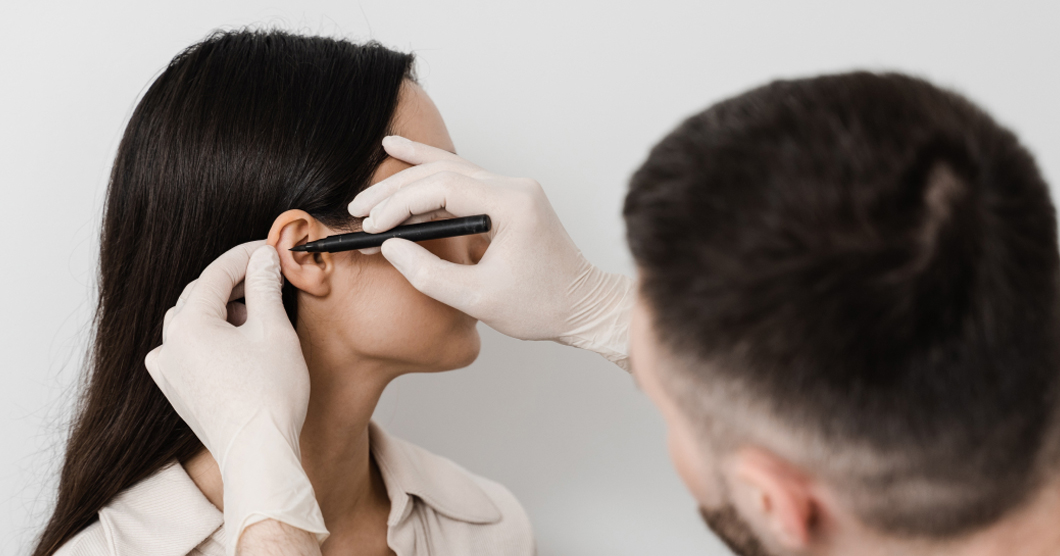Our before-and-after gallery shows the significant improvements created through Dr. Bolden’s expertise. During a consultation, Dr. Bolden will show more before-and-after images of actual ear surgery patients to help patients understand possible results.
20+ years
of experience & counting
100,000+
laser hair removal treatments performed
32+
culturally aware doctors
What is Ear Surgery?
Ear surgery, or otoplasty, is a cosmetic procedure designed to alter the ears’ shape, position, or size. It can correct deformities or imbalances caused by genetics or injury, resulting in ears that appear more natural and proportional to the head and face. At Cultura Dermatology and Plastic Surgery in Washington, DC, Dr. Kelly Bolden, FACS, offers personalized ear surgery options that cater to her patients’ specific needs and aesthetic goals.
The Benefits of Ear Surgery

-
Improved Symmetry
Balances the proportion of the ears in relation to each other and the face.
-
Enhanced Self-Esteem
Reduces the emotional impact of prominent or protruding ears, especially in children and teens.
-
Versatility
Can address a wide range of issues, from overly large ears to those that stick out.
-
Permanent Results
Provides long-lasting results without the need for further procedures.
Good Candidates for Ear Surgery
Ideal candidates for ear surgery are patients dissatisfied with their ears’ size, shape, or protrusion. This includes adults and children – typically, children should be at least 5 years old, as ears are almost fully grown by this age. Candidates should be in good health, non-smokers, and have realistic expectations about the outcomes of the surgery.
Common Ear Shapes for Surgery
- Prominent Ears: Ears that stick out more than usual from the head.
- Constricted Ears: Ears that are overly small or have a cupped shape.
- Stahl’s Ears: Ears with an extra fold of cartilage, giving them a pointed shape.
Results of Ear Surgery
The results of ear surgery are visible immediately, though full results can be seen once swelling and bruising subside. The changes are permanent, giving patients a lifetime of improved appearance and confidence.
self care is self love

Risks of Ear Surgery
As with any surgery, risks include infection, reaction to anesthesia, and dissatisfaction with the aesthetic outcome. Dr. Bolden discusses all potential risks during the consultation so patients can make an informed decision about progressing with surgery.
Read moreCost of Ear Surgery
The cost of ear surgery at Cultura Plastic Surgery varies depending on the procedures performed. During the consultation, Dr. Bolden provides a detailed cost breakdown, including all associated fees and available financing options.
Read morePreparation for ear surgery involves a comprehensive consultation with Dr. Bolden, during which she evaluates the patient's ears, discusses desired outcomes, and explains the procedure. To optimize healing, patients may be advised to stop taking certain medications and to avoid smoking in the weeks leading up to surgery.
The procedure is generally performed under local anesthesia with sedation or general anesthesia, depending on the patient's age and the extent of the surgery. Dr. Bolden uses techniques tailored to the patient's specific needs, ensuring minimal scarring.
Recovery typically involves wearing a headband to support and protect the ears, particularly during sleep. Most patients experience mild discomfort that can be managed with medication prescribed by Dr. Bolden. Children can usually return to school after one week, and adults often resume normal activities within a week.
What to Expect From an Ear Surgery Consultation
During the consultation, Dr. Bolden thoroughly assesses the patient’s ears, discusses their goals, and recommends the best surgical options. This detailed discussion helps set realistic expectations and ensures that each patient feels informed and comfortable with their decision to proceed with ear surgery.


Ear Surgery Techniques
- Ear Pinning: Reduces the angle and distance of the ears from the head, making them less prominent.
- Ear Augmentation: Corrects underdeveloped ears by using implants or restructuring existing tissues.
- Ear Reduction: Removes skin and cartilage to reduce the size of the ears.
- Ear Surgery for Infants: Involves molding and splinting techniques for correcting ear deformities at an early age.












